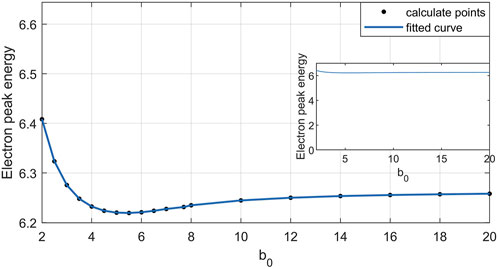- 1Bell Honors School, Nanjing University of Posts and Telecommunications, Nanjing, China
- 2School of Communications and Information Engineering, Nanjing University of Posts and Telecommunications, Nanjing, China
- 3College of Science, Nanjing University of Posts and Telecommunications, Nanjing, China
Based on Thomson scattering classical theory and single-electron model, we explore the influence of variations in the laser beam waist radius on the interaction between an ultra-tightly focused (UTF) laser and off-axis electron. In practical experiments, off-axis collisions predominate, and our study specifically addresses this scenario. Under UTF conditions (
1 Introduction
Over the past few decades, laser technology has advanced rapidly, catalyzing the continuous expansion and deepening of the field of laser-matter interaction [1–3]. Nonlinear inverse Thomson scattering (NITS), as an essential high-quality X-ray source [4, 5], has garnered significant attention from researchers due to its diverse applications ranging from biomedicine to atomic physics [6–8].
NITS devices utilize high-power lasers and relativistic electron beams within a controlled interaction region. Extensive research has been conducted to explore the characteristics of NITS under various parameters, aiming to enhance the modulation of X-rays, as illustrated in Figure 1. Extensive research has explored the characteristics of NITS under various parameters, aiming to enhance the modulation of X-rays [9–11]. Chris Harvey et al. investigated temporal envelope and focusing effects in laser-electron Thomson scattering [12], while S. G. Rykovanov’s team utilized laser chirping to control spectrum broadening for high laser pulse intensities [13].
Previous studies have primarily focused on direct electron collisions with tightly focused laser pulses. However, achieving complete confinement of electron along the laser pulse axis under practical conditions presents significant challenges. Therefore, there is an urgent need to investigate and understand electron-laser interactions under off-axis conditions. Furthermore, there is a lack of research examining the impact of the laser beam waist radius on electron radiation properties, necessitating further investigation.
This paper provides an exploration into how the beam waist radius of a laser pulse influences electron dynamic properties, spatial radiated power characteristics, and spectral attributes during off-axis collisions within a circularly polarized tightly focused laser environment.
The findings demonstrate that the aforementioned characteristics are influenced by the laser beam waist radius, notably revealing distinct properties under ultra-tightly focused (UTF) conditions (
Observable asymmetries also manifest in the radiation’s spatial distribution, temporal spectrum, and angular distribution. A temporal spectral bias towards the x+axis and spatial spectral disparities around 130° and 230° are observed. Increasing the beam waist radius attenuates these asymmetries and reduces axial trajectory shift, electron acceleration, and energy oscillations along the z-direction. This is attributed to reduced laser intensity attenuation and reduced force disparities at electron positions with increased beam waist radius.
The remaining part of this paper is organized as follows: Section 2 derives analytical expressions encompassing the laser pulse vector potential, electron kinematics, radiation spectrum, and power factors, grounded in classical electrodynamics principles. Section 3 examines the influence of the laser beam waist radius on electron motion dynamics, spatial radiated power distribution, and radiation spectrum characteristics. In Section 4, we consolidate the impact of the laser beam waist radius on electron kinematics, spatial radiated power, and radiation spectrum. Furthermore, we explore methods to generate isolated narrow-second pulses with high signal-to-noise ratios by modulating the laser beam waist radius.
2 Theory and formula
In this paper we introduce a Laguerre–Gaussian (LG) laser pulse propagating along the z-axis at a fluctuation angle
Here the wavelength of the laser
the above electric field
Circularly polarized lasers and their electromagnetic fields can be decomposed into x-axis and y-axis linearly polarized lasers whose phase difference is
and the electric field component
where fifth-order expansion of the electromagnetic field accurate to the diffraction angle
when the laser at
The electromagnetic field is fifth-order expanded accurate to the diffraction angle
In the course of the calculation, the focal point of the laser pulse was established as the origin, and the electron move from {
The following Lorentz and energy (Equations 12, 13) can be used to compute the momentum of the electron in an intense laser pulse:
In this context,
When an electron is in relativistic motion, it emits radiation. The radiated power or energy per unit solid angle is given below [18, 19]:
Here, the power radiated per unit solid angle
Lee et al. proposed power factor (Equation 15) as a means of characterizing the peak power radiated by the electron in RNTS [20]:
The equation for the radiant energy per unit steradian angle per unit frequency interval during the interaction of electron with a laser pulse can be expressed as follows [21]:
The normalized expression
3 Numerical results
In our observations, we directed our focus towards the radiation emanating from a precisely defined sphere with a radius of 1 m, positioned at the origin of the coordinate system. The peak amplitude of the laser pulse
3.1 Electronic motion properties
As indicated in Figures 2A–F, the motion trajectories of off-axis electron are finally shifted in the x+axis direction after interacting with the laser at UTF (
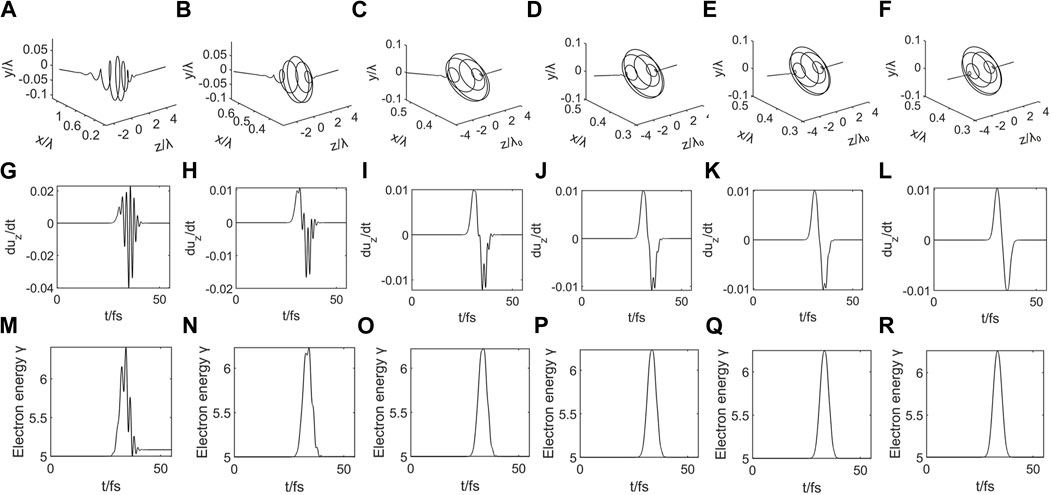
Figure 2. The effect of laser pulses with different laser beam waist radius on the motion of electron, where (A–F) are the trajectory plots of the electron which show the variations in the degree of final axial deflection of the electron, (G–L) are the changes in acceleration of the electron in the z-axis direction at different moments, and (M–R) reflect the variations in the electron energy. (A) b0 = 2λ0. (B) b0 = 4. (C) b0 = 6. (D) b0 = 8. (E) b0 = 10. (F) b0 = 20. (G) b0 = 2. (H) b0 = 4. (I) b0 = 6. (J) b0 = 8. (K) b0 = 10. (L) b0 = 20. (M) b0 = 2. (N) b0 = 4. (O) b0 = 6. (P) b0 = 8. (Q) b0 = 10. (R) b0 = 20.
It can be observed in Figures 2G–L that both the acceleration and deceleration oscillation phenomena along the z-axis are more pronounced at UTF (
Moreover, the electron energy oscillation phenomenon is very significant in the UTF (
The oscillation of electron acceleration and energy is induced by the degree of nonlinearity of the laser. In the realm of UTF (
The graphical representation in Figure 3 illustrates the dynamic relationship between the peak electron energy and the expansion of the laser beam waist radius. Evidently, as the laser beam waist radius transitions from
3.2 Electron space radiation properties of relativistic nonlinear Thomson inverse scattering
3.2.1 Power properties of electron space radiation
Figures 4A–F delineate that the spatial distribution of electron radiated power has an evident asymmetry at UTF (
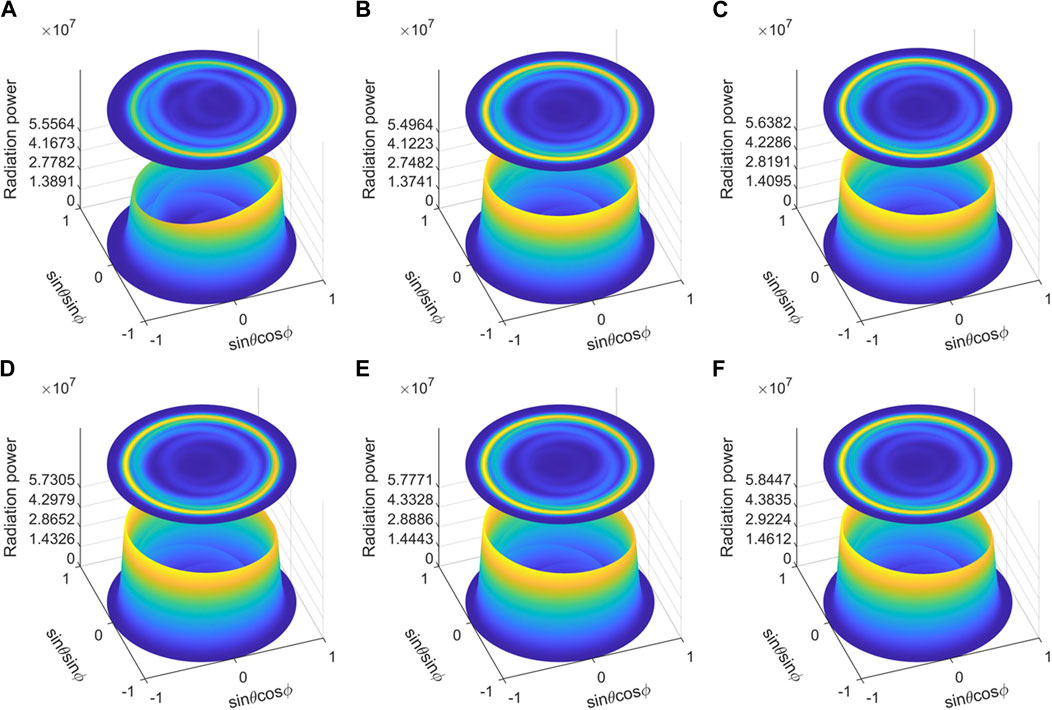
Figure 4. Spatial distribution of electron radiated power in the presence of laser pulses with different beam waist radius
Curve fitting analysis was conducted on the peak power of electron radiation under the influence of laser pulses with varying beam waist radius, and it was found that the peak power of electron radiation shows a changing trend as depicted in Figure 5: Within the range of
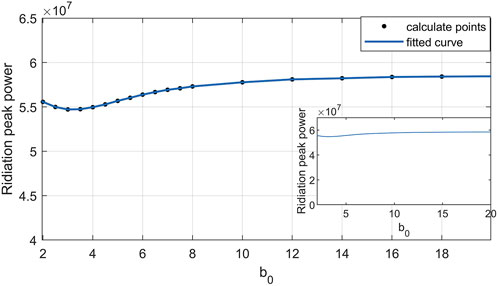
Figure 5. Fitting curves of peak power of electron radiation under the action of laser pulses with different beam waist radius
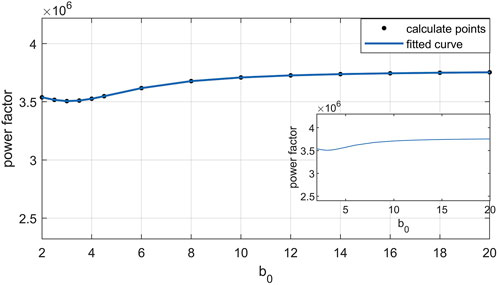
Figure 6. Fitting curves of power factor of electron radiation under the action of laser pulses with different beam waist radius
At
3.2.2 Electron temporal relativistic nonlinear Thomson inverse scattering properties
Figures 7A–F show that at UTF (
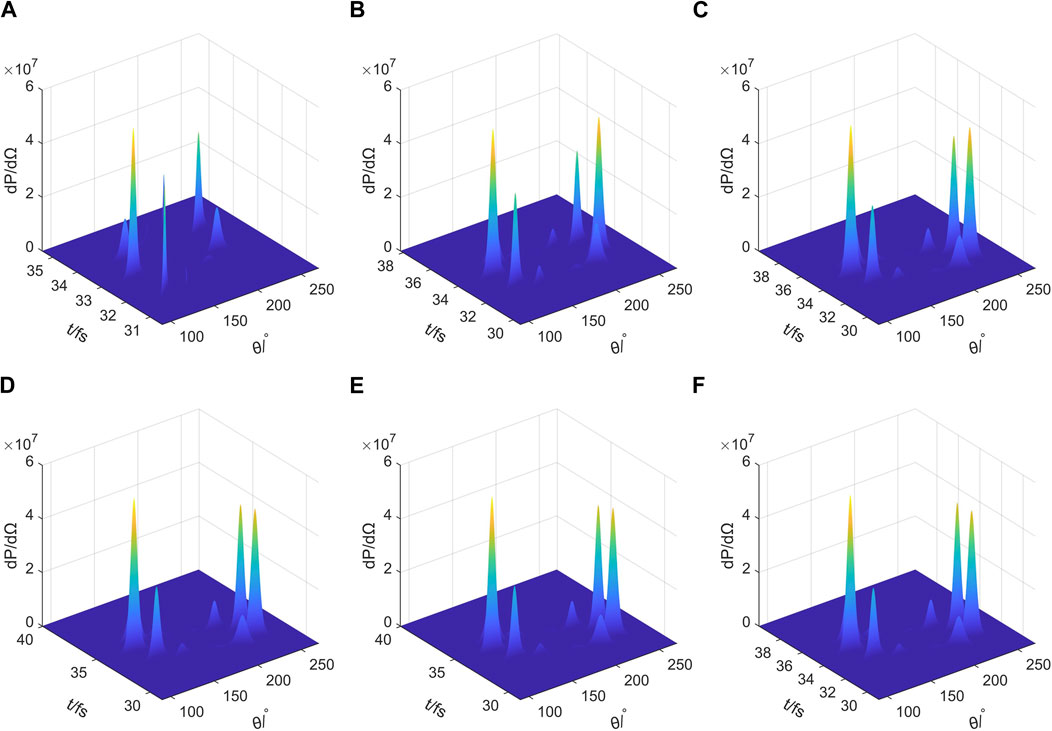
Figure 7. Angular distribution of electron radiation pulse time spectra θ under the action of laser pulses with different beam waist radius
It can be seen from Figures 8A–F that the radiation pulse time spectrum about the phi = 180 asymmetry is conspicuous at UTF (
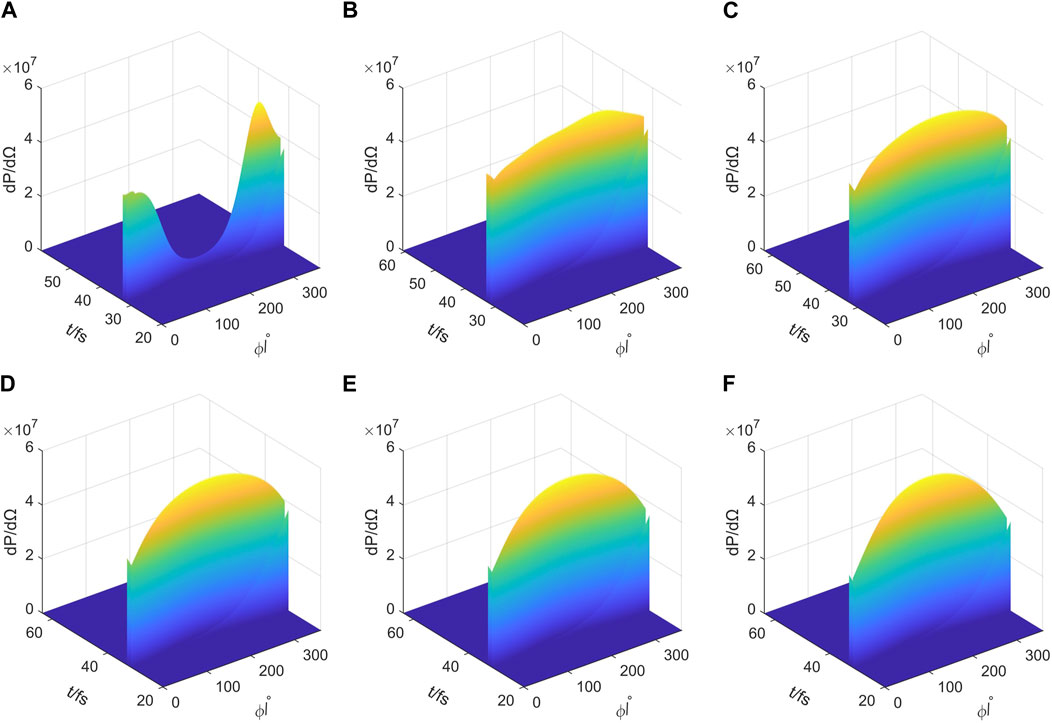
Figure 8. Angular distribution of the electron radiation pulse time spectrum Φ under the action of laser pulses with different beam waist radius
This segment delves into the effect of electron on the time distribution in the direction of peak radiated power generation, modulated by the laser beam waist radius. The comparative analysis employs varied laser beam waist radius
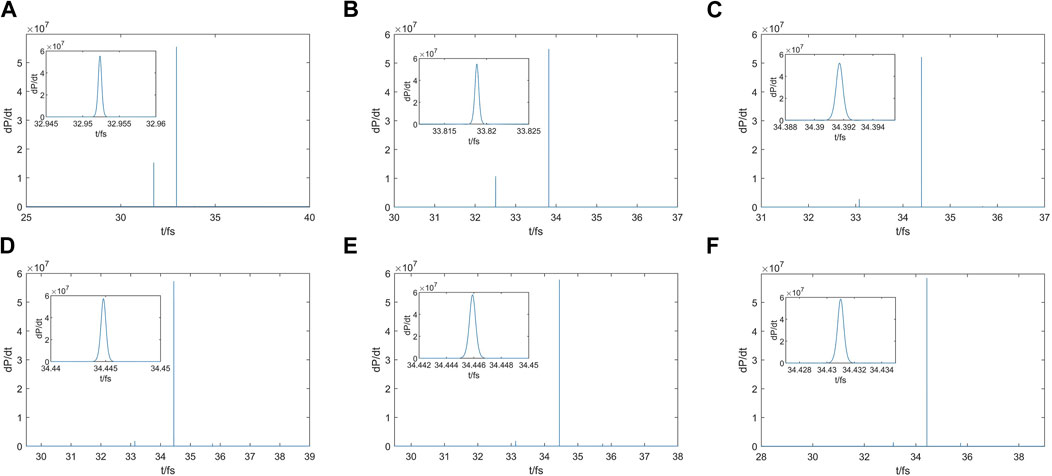
Figure 9. Radiation time distribution in the direction of the maximum power of electron radiation and amplification of the main radiation pulse in the direction of the maximum power of electron radiation in the presence of laser pulses with different beam-waist radius
3.2.3 Spectral properties of electron radiation
Figures 10A–F demonstrate that as the parameter Φ attains its peak radiant power Φ, the spectral radiation reaches its pinnacle intensity, accompanied by the highest peak frequency of the spectral harmonic, occurring at theta of about
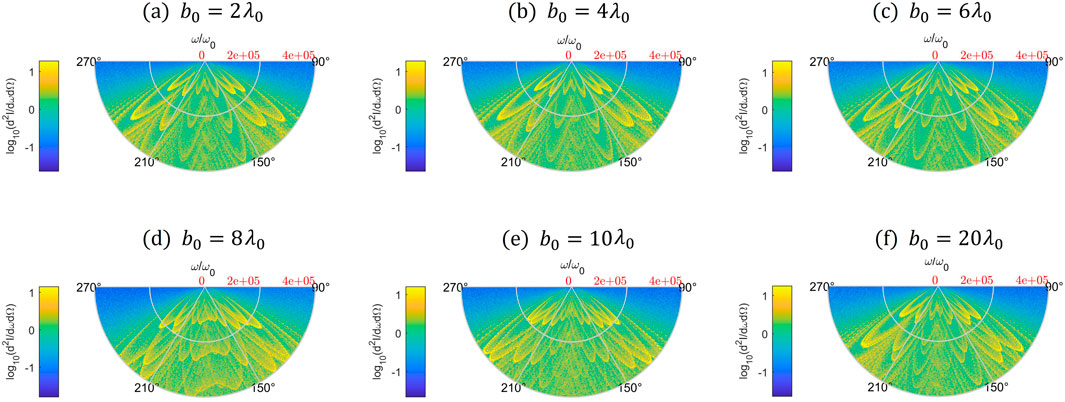
Figure 10. Changes in
As can be seen from Figure 11A, when θ coincides with the peak radiated power θ, the radial distribution of the spectrum is concentrated in the x+axis direction and its vicinity during UTF, with a conspicuous phenomenon of harmonic overlap. Also, the spectral distribution with the x-axis as the symmetry axis exhibits obvious asymmetry. Nonetheless, as
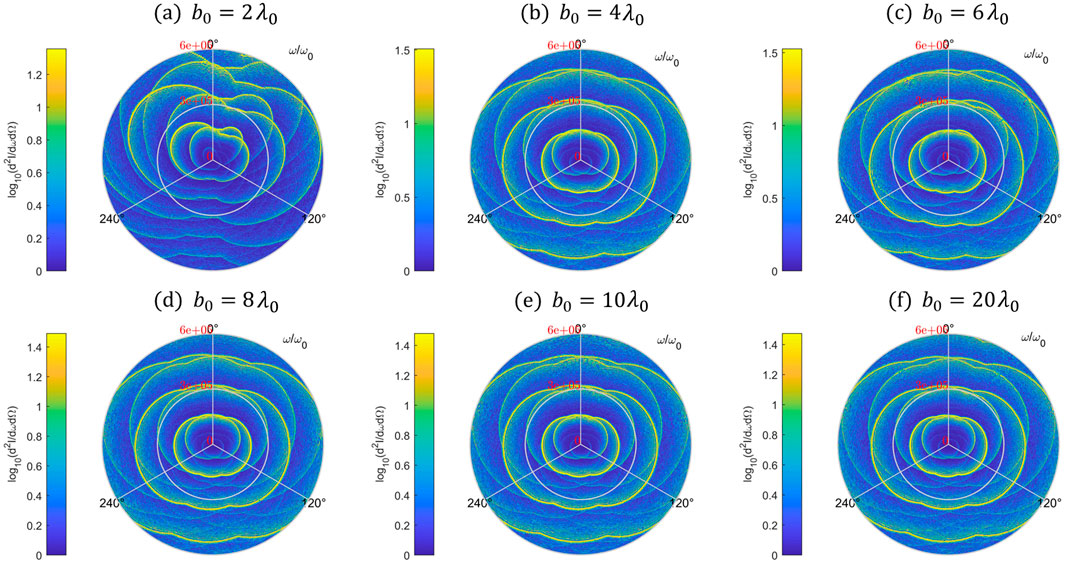
Figure 11. Changes in the Φ angular distribution of the spatial radiation spectra of electron in the presence of laser pulses with different beam waist radius
4 Conclusion
In this investigation, we carefully explore the effect of laser beam waist radius variations on the radiation properties in nonlinear Thomson scattering, particularly as it pertains to the interaction with off-axis electron. In practical experimental setups, the prevalent scenario involves electron engaging in off-axis collisions, underscoring the profound practical relevance of our study. Under conditions of UTF, denoted by
Simultaneously, significant asymmetry emerges in the spatial distribution of the electron-radiated power, the temporal spectrum of the electron-radiated pulse, and the angular distribution of the spatial radiation spectrum. Specifically, the radiated pulse power within the temporal spectrum exhibits a marked bias towards the x+axis direction. Moreover, the spatial spectrum’s asymmetry manifests in the disparities observed in spectral peak radiation intensity and harmonic peak frequency at angles around 130°and 230° when Φ coincides with the peak radiated power Φ,and when θ serves as the peak radiant power reference, the spectral distribution showcases evident asymmetry.
With an increase in the beam waist radius
In summary, the manipulation of the laser beam waist radius, particularly when
Data availability statement
The raw data supporting the conclusions of this article will be made available by the authors, without undue reservation.
Author contributions
QZ: Conceptualization, Data curation, Methodology, Writing–original draft, Writing–review and editing. JL: Formal Analysis, Supervision, Writing–review and editing. ZW: Data curation, Writing–original draft. YT: Conceptualization, Writing–review and editing.
Funding
The author(s) declare that no financial support was received for the research, authorship, and/or publication of this article.
Conflict of interest
The authors declare that the research was conducted in the absence of any commercial or financial relationships that could be construed as a potential conflict of interest.
Publisher’s note
All claims expressed in this article are solely those of the authors and do not necessarily represent those of their affiliated organizations, or those of the publisher, the editors and the reviewers. Any product that may be evaluated in this article, or claim that may be made by its manufacturer, is not guaranteed or endorsed by the publisher.
References
1. Wiste T, Maliuk O, Tikhonchuk V, Lastovicka T, Homola J, Chadt K, et al. Additive manufactured foam targets for experiments on high-power laser–matter interaction. J Appl Phys (2023) 133:043101. doi:10.1063/5.0121650
2. Sun J, Wang S, Zhu W, Li X, Jiang L. Simulation of femtosecond laser-induced periodic surface structures on fused silica by considering intrapulse and interpulse feedback. J Appl Phys (2024) 136:013103. doi:10.1063/5.0205299
3. Bergner K, Flamm D, Jenne M, Kumkar M, Tünnermann A, Nolte S. Time-resolved tomography of ultrafast laser-matter interaction. Opt Express (2018) 26:2873–83. doi:10.1364/oe.26.002873
4. Frydrych S, Vorberger J, Hartley NJ, Schuster AK, Ramakrishna K, Saunders AM, et al. Demonstration of X-ray Thomson scattering as diagnostics for miscibility in warm dense matter. Nat Commun (2020) 11:2620. doi:10.1038/s41467-020-16426-y
5. Chi Z, Du Y, Huang W, Tang C. Linearly polarized X-ray fluorescence computed tomography based on a Thomson scattering light source: a Monte Carlo study. J Synchrotron Radiat (2020) 27:737–45. doi:10.1107/s1600577520003574
6. Panetta D, Labate L, Billeci L, Di Lascio N, Esposito G, Faita F, et al. Numerical simulation of novel concept 4D cardiac microtomography for small rodents based on all-optical Thomson scattering X-ray sources. Sci Rep (2019) 9:8439. doi:10.1038/s41598-019-44779-y
7. Yamaguchi R, Tanaka G, Shafii NS, Osman K, Shimizu Y, Saqr KM, et al. Characteristic effect of wall elasticity on flow instability and wall shear stress of a full-scale, patient-specific aneurysm model in the middle cerebral artery: an experimental approach. J Appl Phys (2022) 131:184701. doi:10.1063/5.0085417
8. Vais OE, Bychenkov VY. Nonlinear Thomson scattering of a tightly focused relativistically intense laser pulse by an ensemble of particles. Quan Electron. (2020) 50:922–8. doi:10.1070/qel17344
9. Chi Z, Du Y, Huang W, Tang C. Focal spot characteristics of Thomson scattering x-ray sources. J Appl Phys (2018) 124:124901. doi:10.1063/1.5048457
10. Chang Y, Zeng Z, Wang C, Long Z, Tian Y. Modulation of high-energy γ-rays by collision of an ultra-high-energy electron with a tightly focused circularly polarized laser pulse. Appl Opt (2022) 61:6038–45. doi:10.1364/ao.459665
11. Wang Y, Zhou Q, Zhuang J, Yu P, Tian Y. Vortex and symmetric radiation character of nonlinear Thomson scattering in Laguerre-Gaussian circularly polarized laser pulses. Opt Express (2021) 29:22636–47. doi:10.1364/oe.426529
12. Harvey C, Marklund M, Holkundkar AR. Focusing effects in laser-electron Thomson scattering. Phys Rev Accel Beams (2016) 19:094701. doi:10.1103/physrevaccelbeams.19.094701
13. Rykovanov SG, Geddes C, Schroeder C, Esarey E, Leemans W. Controlling the spectral shape of nonlinear Thomson scattering with proper laser chirping. Phys Rev Accel Beams (2016) 19:030701. doi:10.1103/physrevaccelbeams.19.030701
14. Barton JP, Alexander DR. Fifth-order corrected electromagnetic field components for a fundamental Gaussian beam. J Appl Phys (1989) 66:2800–2. doi:10.1063/1.344207
15. Salamin YI, Keitel CH. Electron acceleration by a tightly focused laser beam. Phys Rev Lett (2002) 88:095005. doi:10.1103/physrevlett.88.095005
16. Zhang SY. Accurate correction field of circularly polarized laser and its acceleration effect. J Mol Sci (2010) 1:308–17. doi:10.4208/jams.042110.051010a
17. Wang Y, Yang Q, Chang Y, Lin Z, Tian Y. Collision off-axis position dependence of relativistic nonlinear Thomson inverse scattering of an excited electron in a tightly focused circular polarized laser pulse. Chin Phys B (2023) 33:013301. doi:10.1088/1674-1056/acd921
18. He F, Lau Y, Umstadter DP, Kowalczyk R. Backscattering of an intense laser beam by an electron. Phys Rev Lett (2003) 90:055002. doi:10.1103/physrevlett.90.055002
19. He F, Yu W, Lu P, Xu H, Qian L, Shen B, et al. Ponderomotive acceleration of electrons by a tightly focused intense laser beam. Phys Rev E (2003) 68:046407. doi:10.1103/physreve.68.046407
20. Lee H, Kim D, Chung S, Lee K. Attosecond keV x-ray pulses driven by Thomson scattering in a tight focus regime. New J Phys (2009) 11:063050. doi:10.1088/1367-2630/11/6/063050
Keywords: beam waist, circularly polarized laser, laser physics, ultra-tightly focused laser, offaxis electron, relativistic nonlinear Thomson scattering
Citation: Zheng Q, Li J, Wang Z and Tian Y (2025) Relativistic nonlinear Thomson scattering of excited electron in ultra-tightly focused circularly polarized laser pulses with different beam waist radius. Front. Phys. 13:1500137. doi: 10.3389/fphy.2025.1500137
Received: 22 September 2024; Accepted: 16 January 2025;
Published: 07 February 2025.
Edited by:
Xiao Xu, Leibniz Institute for Solid State and Materials Research Dresden (IFW Dresden), GermanyReviewed by:
Jiawei Sun, Shanghai Articial Intelligence Laboratory, ChinaWuxiong Cao, Harbin Institute of Technology, China
Copyright © 2025 Zheng, Li, Wang and Tian. This is an open-access article distributed under the terms of the Creative Commons Attribution License (CC BY). The use, distribution or reproduction in other forums is permitted, provided the original author(s) and the copyright owner(s) are credited and that the original publication in this journal is cited, in accordance with accepted academic practice. No use, distribution or reproduction is permitted which does not comply with these terms.
*Correspondence: Qianmin Zheng, cTIyMDEwMzAzQG5qdXB0LmVkdS5jbg==
 Qianmin Zheng
Qianmin Zheng Jiachen Li
Jiachen Li Zi Wang2
Zi Wang2
